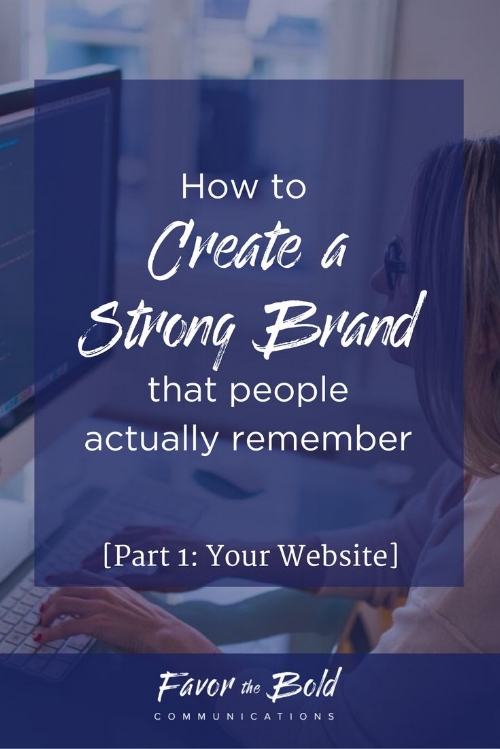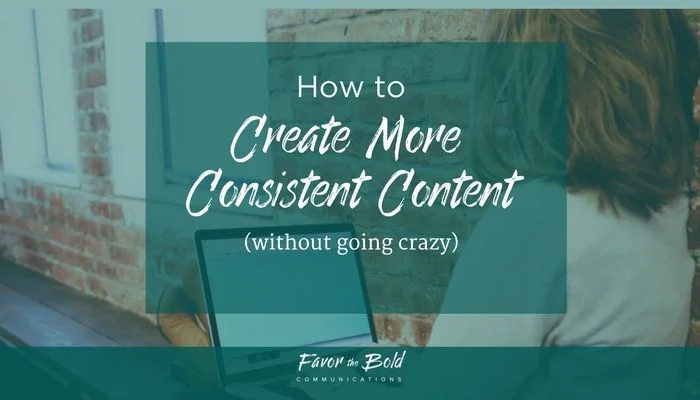Pop quiz: when you think of the word “brand”, what’s the first thing that comes to mind?
You’re probably thinking about one of the big guys: Coca-Cola, Mercedes, Apple. And most likely, you have an impression of each, whether or not you have first-hand experience with their products.
THAT’s the power of a strong brand: it’s not only memorable, but it also makes an impression. And that should be the goal for your brand.
Be memorable. Be recognizable. Make an impact.
We all know this, right?
But that’s where so many businesses struggle. They have a logo, start a couple social media accounts and think their branding work is done. What they don’t realize is that strong branding goes way, WAY beyond their logo.
I’ve talked before about the four things every brand needs to stand out. If you haven’t read that post, go check it out and then meet me back here. Because today, we’re talking about how to use those things to create a strong, recognizable brand.
And, spoiler alert, that “how” can be summed up in one word: Consistency.
Consistency is key in any communication, but in branding, it is THE make-or-break factor. So let’s talk about how to achieve it. There's a LOT to cover, so I’m breaking this post up into a series.
This first one will focus on keeping your brand consistent on your website.
Oh man, I could write a whole book about mistakes business make on their websites-- and brand consistency would take up several chapters. (And yes, that's my way of warning you that this post is a beast...)
There are SO many ways businesses get this wrong. Let’s jump into some of the big ones.
1. Visual identity
So, you’ve worked with a designer or have created your own brand. You have a logo, a few logo variations, your brand colors, fonts and maybe even a few patterns or other visual elements to use.
You’re ready to rumble.
So you start applying everything to your website. So far, so good.
But after a blog post or two, you start to feel like your site looks a little boring. Those same three or four fonts are starting to look stale. Your colors aren’t popping the way they used to. What if you just add a new color in for this blog post? It’s starting to be autumn, maybe we can use some “fall colors”, just this once.
And this, my friends, is how it starts.
Stick to your brand's visual identity
With every new color or font you add to “make things more interesting”, your brand dies a slow, painful death. That carefully crafted identity you’ve built gets diluted with things like “fall colors” and “fun headers” until your brand is unrecognizable, and, more importantly, wholly forgettable.
So please, for the love of god, stick to your brand’s visual identity.
While your site might feel boring to you, the average visitor isn’t spending nearly as much time looking at it as you do. They aren’t bored with the same colors and fonts-- they’re reassured. They know what to expect and appreciate the stability.
Don’t believe me? Look at what happens any time Facebook changes anything: users freak the f--k out.
People don’t like change. And if you’re constantly changing your website’s look and feel, they won’t like you either.
2. Graphics and images
You see this all the time: a website with a logo that’s fun and creative, right above a boring stock photo of white dudes in suits.
I’m not going to get into all the ways that sucks (mainly because after a decade in corporate communications, I have “white-dudes-in-suits” PTSD and can’t possibly be objective.) But I will say that from a consistency perspective, that kind of thing murders a brand’s impact.
Often, the graphics for your website are an afterthought, but they really shouldn’t be: your images are the very first things visitors see when they land on your site.
So they better be branded.
That’s not to say you can’t use stock photos. Most of us don’t yet have the cash flow to have a pro photographer come in every time we have a new blog post. By all means, use those stock photos, but make sure they’re in line with your branding. That means:
The photos fit the look and feel of your brand
If your brand is bright and fun, the stock photos you choose should also be bright and fun (or you should customize them to be so). They should use colors similar to the rest of your visual identity. They should fit the overall impression you’re trying to give with the rest of your brand elements.
You’ve customized stock images to fit your branding
Don’t freak out, I’m not asking you to start changing things in Photoshop. Branding stock images is super easy with tools like Canva, which you can use to add a filter with one of your brand colors or text with one of your fonts. Trying to figure out what I’m talking about? The image for this blog post is a free stock photo I branded in Canva.
The photos fit your audience
Remember my white-dudes-in-suits example? That’s what I’m talking about here. If your audience is stay at home moms looking to make money online, you don’t want photos of women in a board room dressed in "business formal" (I’m lookin’ at you, pastel-collared-shirt-under-a-suit-jacket.) Make sure the images you’re using are not only attractive, but are also relatable to your audience.
The photos fit with each other
When you’re choosing stock photos, look at them as a whole. It’s easy sometimes to fall down the stock photo rabbit hole and start downloading anything that’s pretty and uses your brand colors, but remember: they need to be consistent. That means it’s not just about color, but also about what’s in the pictures. If all of your images are interior shots, that one random picture of a woman watching a sunset on the beach is going to look like it doesn’t belong. Pick a theme and stick to it.
3. Content and messaging
Like your visual identity and graphics, the various content on your site needs to fit together in a coherent way.
Why is this important? Because the goal of your website is to show that you’re an expert in what you do. Your website should clearly demonstrate to visitors within about 30 seconds what you do, who you do it for and why they need it. If your content is all over the place, you risk confusing them.
And, let me tell ya, a confused audience isn’t likely to stick around very long.
So let’s talk about how to make sure your content is consistent.
Focus on one main topic for your content
I know that sounds obvious, but it isn’t always easy. Anyone who decides to get out of their comfort zone and start their own business is also likely to be the kind of person who loves to try new things. We aren’t just passionate about our work, we’re passionate about life. We’re interested in SO many different topics, and we want to share what we know with others.
Which is a freaking minefield when it comes to your content.
So if you’re a communications and branding strategist who happens to love personal development, food, travelling, productivity hacks, wine, running, minimalism, languages and more wine (this is obviously hypothetical, I totally don’t know ANYONE like this), you need to get focused. Your interests can come out in your content when appropriate, but they shouldn’t distract from the most important objective of your website: giving your visitors what they want.
Because remember, your content isn’t for you, it’s for your audience. If they’re on your blog for communications advice, do not make them click through healthy recipes to find it.
All categories should apply to your target audience
That’s not to say that if you’re a communications guru, you should ONLY write about communications. Your audience might come for the communications, but they’ll stay for other relevant advice that’s applicable to them.
For example, my audience is mostly creative solopreneurs on their first business venture. Many of them are new to running a business, so they're happy to get any advice they can on how to make their business-running lives easier. So, in addition to communications and branding advice, I also blog about productivity, behind-the-scenes business tips and the mindset shifts necessary to successfully run a business.
It’s not all communications and branding all the time, but those other topics are related to the unique issues my audience faces. So as much as I (hypothetically) love wine, writing a whole blog post about it probably won’t serve my audience.
Unless, you know, I can somehow convince them that drinking wine can help their business.
Give yourself time
All of that said, if you’re just starting out, you might not know exactly what your focus should be. Just look at me: my early blogs were all over the place. Communication one week, meditation the next, with tons of random personal development sprinkled in. My audience could watch in real time as my blog wandered around, bumping into things and opening doors to the wrong rooms while I struggled to figure out what I wanted to share with my audience.
So if you’re just starting out, shoot for coherent, consistent content, but give yourself a little grace if it takes time to figure out your focus.
4. Copy and tone
Your brand voice is your brand’s personality. It’s how your business “talks”: the words, the tone, the values, the beliefs. And it’s one of the main ways your brand attracts your ideal audience. Which is why it’s so important that your brand voice is consistent across your website.
Personality on every page
Have you ever landed on a blog post and loved the way it was written? You soak up all that well-worded wisdom and then immediately click over to “About me” because you just have to know more about this person.
And then?
Wah waaaaah.
It’s like the About page was written by someone else entirely. The self-deprecating humor that you loved in the blog post has been replaced by a corporate-buzzword-speaking robot who takes herself waaaay too seriously. The fun graphics and bright colors on the blog’s side bar have been swapped out by a sterile head shot. The whole thing is so boring, you close out of the window without even finishing it and forget about the entire experience immediately.
This is why it’s so important to create a consistent, compelling brand voice: your brand voice is how your audience gets to know you. It’s the reason they choose you, not one of your competitors. It’s the way they see the human behind the content.
You want every single page of your website to have your brand’s voice so that a visitor’s experience feels fluid and consistent. You want them to recognize your voice, get used to hearing it and eventually want to hear it more so they keep coming back for it.
Keep your copy consistent
Ok, this might be the Type A perfectionist communications nerd in me, but I have a branding pet peeve that I see all the time on websites: inconsistent wording.
On one page, the company is described as an agency, on the next, it’s a studio. On one page, the company is referred to as “we,” on the next, it’s “it” or “I.”
I know these are little niggly complaints, but it matters.
It matters because every time your copy swings back and forth between “I” and “we,” the reader has to think. We have to remember who those words refer to and wonder why sometimes it’s one and sometimes it’s the other. It distracts us from the content itself and why we’re really there: to get the information we need, and decide whether or not we want to stick around.
Of course, not everyone cares about that level of detail, but if you’re a business, you better believe potential clients are paying attention.
Regardless of your brand’s personality, potential clients expect a certain level of professionalism before they’re likely to give you their money. Even if your voice is casual and fun, even if the “F word” is your favorite word (so many exciting variations!), appearing careless or inconsistent in your website copy makes you look unreliable and inattentive.
Which, needless to say, are rarely characteristics that will help you get hired.
So while my obsession with consistency might seem pedantic, please believe me that it’s important. So important, in fact, that I have two more posts about how to use consistency to create a recognizable, memorable brand that makes an impact. To make sure you don't miss 'em, sign up for my email list by clicking the pink button below.






